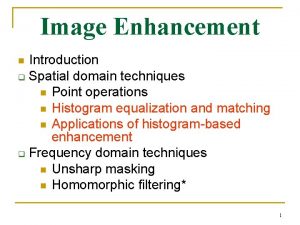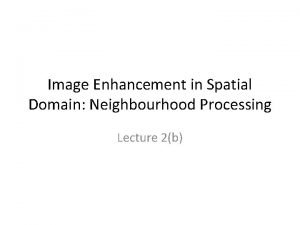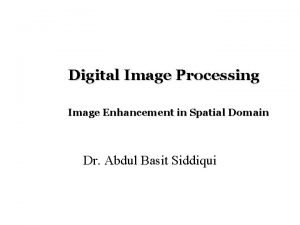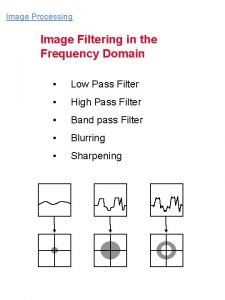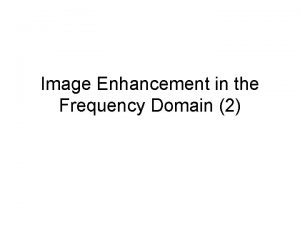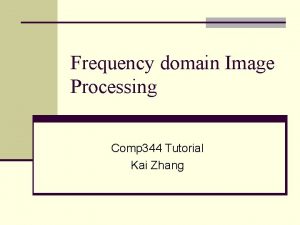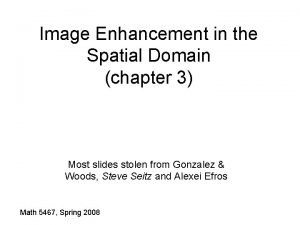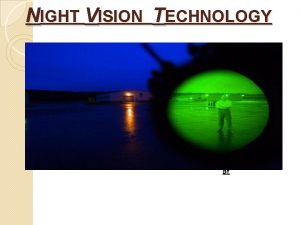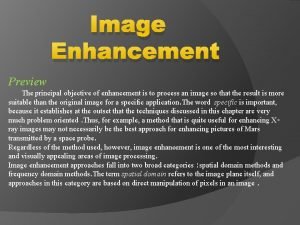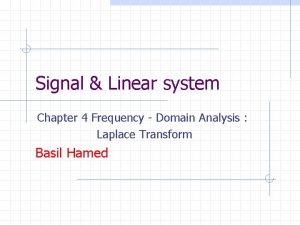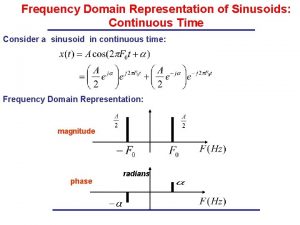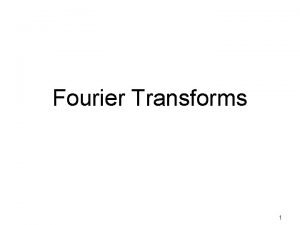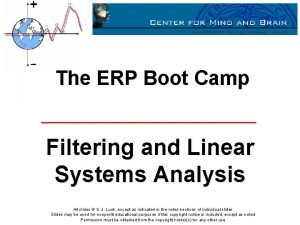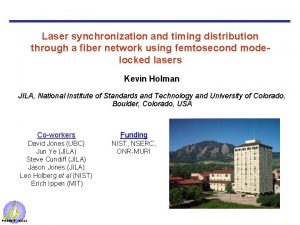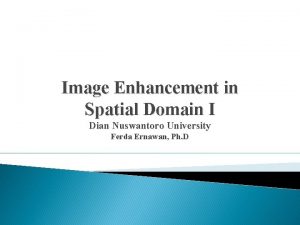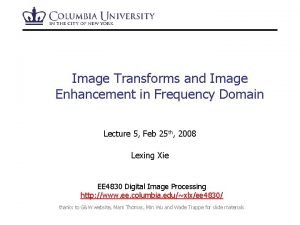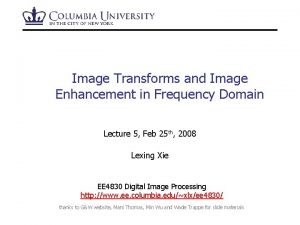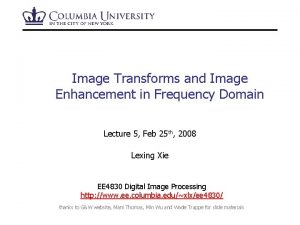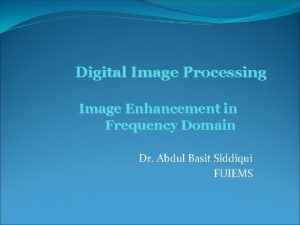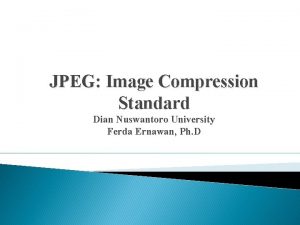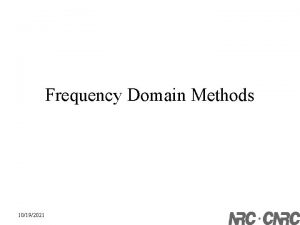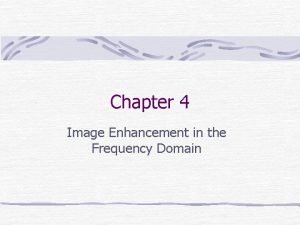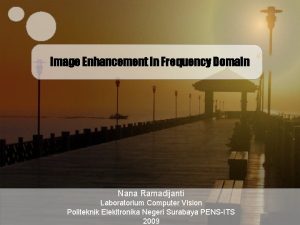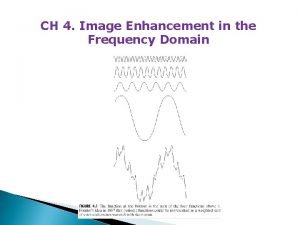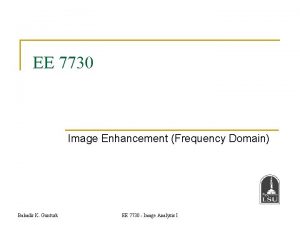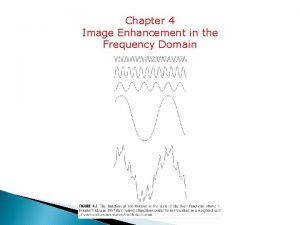Image Enhancement in the Frequency Domain Dian Nuswantoro































- Slides: 31

Image Enhancement in the Frequency Domain Dian Nuswantoro University Ferda Ernawan, Ph. D

The content of lecture � This ◦ ◦ ◦ ◦ ◦ lecture will cover: Fourier Transform Discrete Fourier Transform-1 D Fast Fourier Transform-1 D Advantage and Disadvantage of FFT DCT-1 D DFT-2 D operations DCT-2 D Basic Step Filtering in the frequency domain Smoothing frequency domain filter

The Fourier Transform � The Fourier Transform is a mathematical procedure which can be thought of as transforming a function from the time domain to the frequency domain. � A modified form of the Fourier Transform, known as the discrete Fourier transform (DFT), it is used sample (discrete) signals. � Another signal transforms is fast Fourier transform (FFT), it distinguishes itself from the Fourier transform. FFT allows the DFT of a sampled signal to be obtained rapidly and efficiently to be evaluated with a significant reduction in the amount of calculation required Jean Baptiste Joseph Fourier

The Fourier Transform � The Fourier Transform is a fundamental importance to image processing. � The Fourier transform provides an explicit method for converting from time domain to frequencies domain. The following defines the Fourier transform of : � Based on the mathematical identity that relates these constants to the sine and cosine function:

Discrete Fourier Transform-1 D � A modified form of the Fourier Transform, known as the Discrete Fourier Transform (DFT), uses sample discrete signals. The performance of DFT requires the order of computations involving complex arithmetic operations, addition and multiplication. The outcome of DFT is a set of sine and cosine coefficients. � The inverse Discrete Fourier Transform is given by the following equation: � �

Fast Fourier Transform-1 D � Another signal transform is Fast Fourier Transform (FFT). It distinguishes itself from the Fourier transform. � FFT allows the Discrete Fourier Transform of a sampled signal to be obtained rapidly and efficiently so as to be evaluated with a significant reduction in the amount of calculation required. � The Fast Fourier Transform is simply a class of special algorithms which manipulate the DFT with considerable savings in computational time.

Fast Fourier Transform-1 D � According to Johnson and Frigo (2007), Fast Fourier Transform algorithms compute the DFT of size N in operation. � The FFT is an algorithm which is designed to compute the DFT very efficiently. � FFT is a complex transform which requires operation on an imaginary number and special algorithm.

FFT-1 D � FFT is the collection of computationally efficient algorithms that perform the discrete Fourier transform (Lo, Miri & Tet, 2005). � FFT is applied in order to convert signals into the frequency domain. � The following equation defines the fast Fourier transform of: � The inverse Fast Fourier Transform is given by the following equation:

Advantage of FFT � The Fast Fourier Transform takes advantage of the symmetry and periodicity properties of the Fourier Transform to reduce computation time. FFT algorithm reduces the time complexity from to (Guo-qiang & Ming-he, 2005). � Many FFT algorithms operate by the divide-and conquer method. In this process, the transform is partitioned into a sequence of reducedlength transforms that are collectively performed with reduced workload (Rapuano & Harris, 2007).

Disadvantage of FFT � The FFT technique also has limitation in its performance. FFT is a complex transform which requires operating on an imaginary number and especial algorithm. � It is a complex exponential that defines a complex sinusoid with frequency.

Discrete Fourier Transform-2 D The Discrete Fourier Transform of f(x, y), for x = 0, 1, 2…M-1 and y = 0, 1, 2…N-1, denoted by F(u, v), is given by the equation: for u = 0, 1, 2…M-1 and v = 0, 1, 2…N-1.

DFT-2 D Operation

Inverse Discrete Fourier Transform-2 D It is really important to note that the Fourier transform is completely reversible. The inverse DFT is given by: for x = 0, 1, 2…M-1 and y = 0, 1, 2…N-1

DCT � The Discrete Cosine Transform (DCT) is one of the most well known transforms in image processing, and is used in many different fields, including JPEG compression. � The DCT is a Fourier-Related transform similar to the discrete Fourier transform (DFT), but it only uses the real numbers. � It is equivalent to a Discrete Fourier Transform (DFT) of most probably twice the length, operating real data with even symmetry, where in some variants the input and output data are shifted by half a sample.

Discrete Cosine Transform-1 D � The Discrete Cosine Transform (DCT) was introduced by Ahmed, Natarajam and Rao (1997). � DCT is a discrete transform whose kernel is defined by the cosine function. where all the coefficient are real number and

Inverse DCT-1 D � The inverse of DCT (IDCT) is given in the following equation: where all the coefficient are real number and

DCT-2 D � The DCT of a signal f(x, y) are given as follows: • The inverse DCT of coefficient F(u, v) are given by: Where

Review � Remember-The purpose of the transformation domain is to transform the value of pixels to the spatial frequencies. Suggested readings: implementation issues on DFT-2 D in Matlab (Gonzalez Section 4. 6)

Image Enhancement Filtering In the Frequency Domain

Basic steps for filtering in the frequency domain To filter an image in the frequency domain: 1. 2. 3. Compute F(u, v) the DFT of the image Multiply F(u, v) by a filter function H(u, v) Compute the inverse DFT of the result

Smoothing Frequency Domain Filters Smoothing is achieved in the frequency domain by dropping out the high frequency components. The basic model for filtering is: G(u, v) = H(u, v)F(u, v) where F(u, v) is the Fourier transform of the image being filtered and H(u, v) is the filter transform function.

cont… The transfer function for the ideal low pass filter can be given as: where D(u, v) is the distance from point (u, v), the equation is given as:

Gaussian Lowpass Filters The transfer function of a Gaussian lowpass filter is defined as:

Gaussian High Pass Filters The Gaussian high pass filter is given as: where D 0 is the cut off distance as before

Sharpening in the Frequency Domain Øsharpen (or shows the edges of) an image Edges and fine detail in images are associated with high frequency components. ØHigh pass filters – only pass the high frequencies, drop the low ones ØHigh pass frequencies are precisely the reverse of low pass filters, so: Hhp(u, v) = 1 – Hlp(u, v)

Gaussian High Pass Filters (cont…) Results of Gaussian high pass filtering with D 0 = 15 , D 0 = 30, D 0 = 80

High Pass Filtering Results of Gaussian high pass filtering with D 0 = 15

High Pass Filtering Results of Gaussian high pass filtering with D 0 = 30

High Pass Filtering Results of Gaussian high pass filtering with D 0 = 45

References � � � Johnson, S. G. and Frigo, M. (2007). A Modified Split-Radix FFT With Fewer Arithmetic Operations. IEEE Transactions on Signal Processing, Vol. 55, No. 1, pp. 111 -119. Lo, S. C. , Miri, A. , Tet, H. Y. (2005). Efficient FPGA implementation of FFT based multipliers. Canadian Conference on Electrical and Computer Engineering, pp. 1300 -1303. Rapuano, S. and Harris, F. (2007). An Introduction to FFT and Time Domain Windows. IEEE Instrumentation and Measurement Magazine, Vol. 10, No. 6, pp. 32 -44.

� Practicum : Sharpening in the frequency domain
 Image enhancement in spatial domain
Image enhancement in spatial domain Image enhancement in spatial domain
Image enhancement in spatial domain Image enhancement in spatial domain
Image enhancement in spatial domain Image enhancement in spatial domain
Image enhancement in spatial domain Z domain to frequency domain
Z domain to frequency domain Trapezoidal wave fourier series
Trapezoidal wave fourier series Z domain to frequency domain
Z domain to frequency domain The z transform of np
The z transform of np Band pass filter in image processing
Band pass filter in image processing Frequency domain image
Frequency domain image Image processing frequency domain
Image processing frequency domain What is enhancement in the spatial domain?
What is enhancement in the spatial domain? Image enhancement in night vision technology
Image enhancement in night vision technology Objective of image enhancement
Objective of image enhancement Image quality repair
Image quality repair Image enhancement by point processing
Image enhancement by point processing Inverse log transformation in image processing
Inverse log transformation in image processing Image enhancement
Image enhancement How to find conditional relative frequencies
How to find conditional relative frequencies How to calculate relative frequency
How to calculate relative frequency Angular frequency to frequency
Angular frequency to frequency Vmax= aw
Vmax= aw Frequency vs relative frequency
Frequency vs relative frequency Marginal frequency table
Marginal frequency table Joint frequency
Joint frequency Laplace frequency domain
Laplace frequency domain Series de fourier
Series de fourier Fourier series linearity
Fourier series linearity Circular convolution theorem
Circular convolution theorem Time frequency domain
Time frequency domain Time frequency domain
Time frequency domain Dian henderson
Dian henderson

